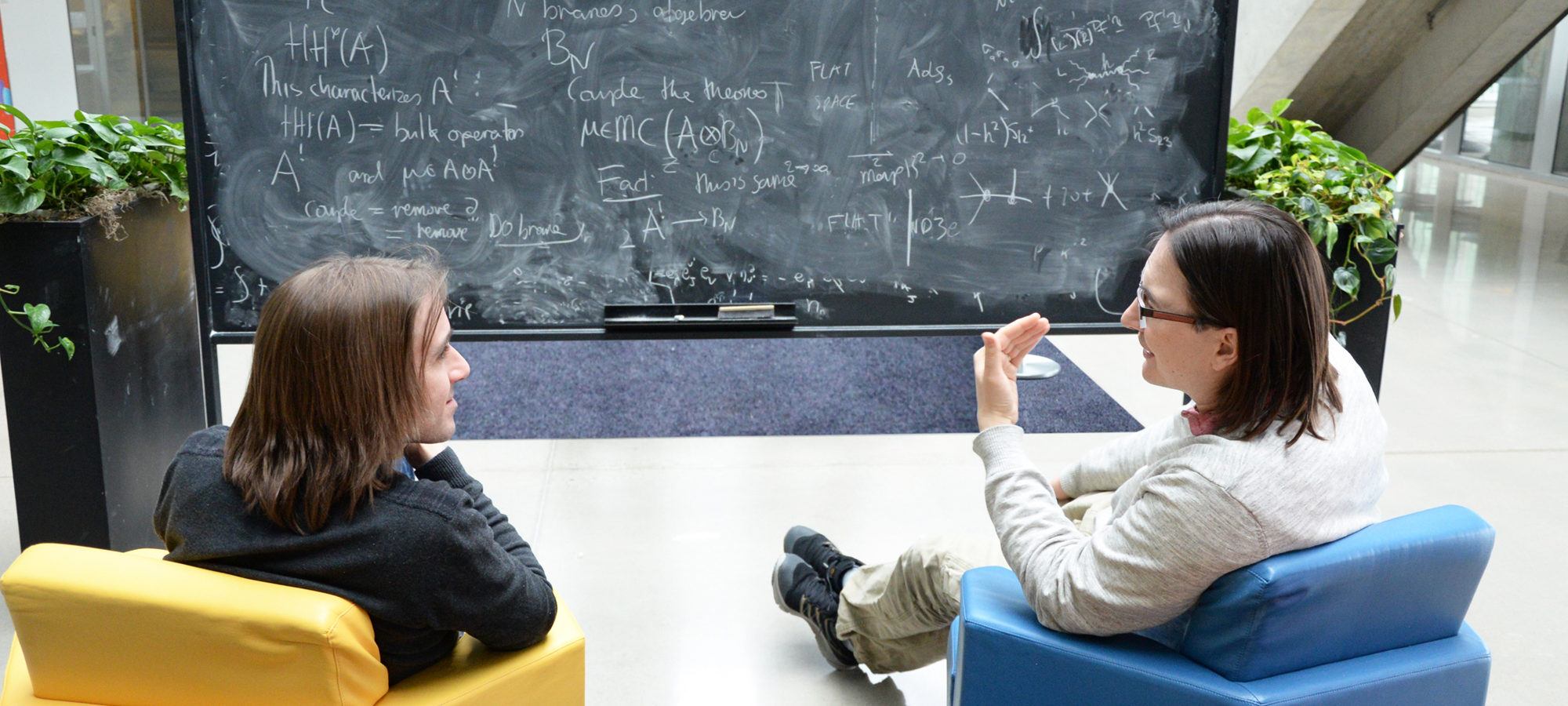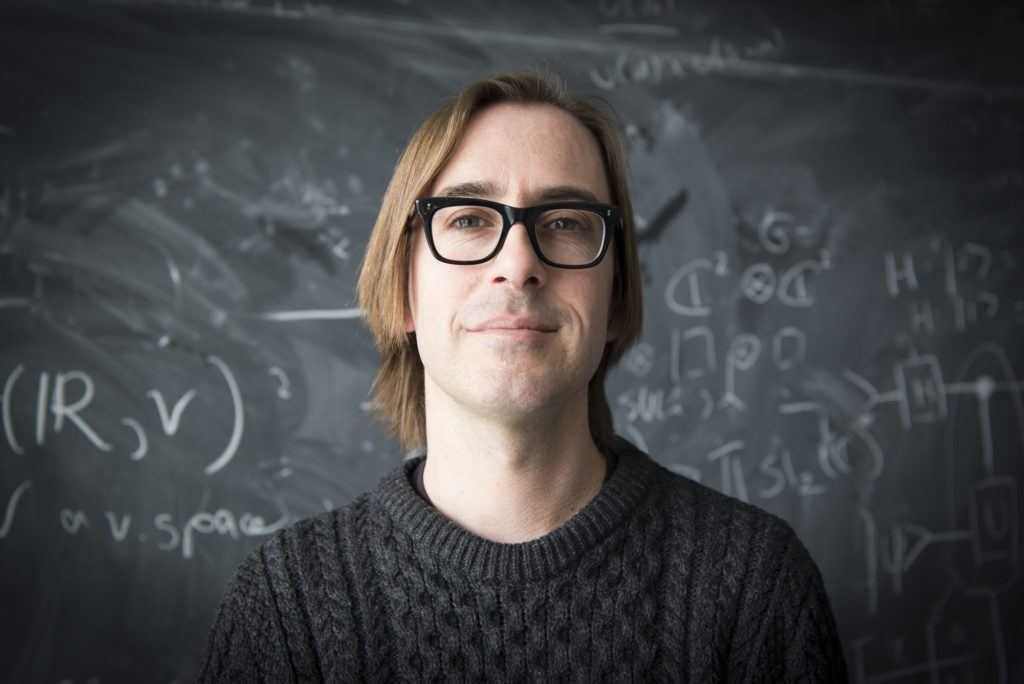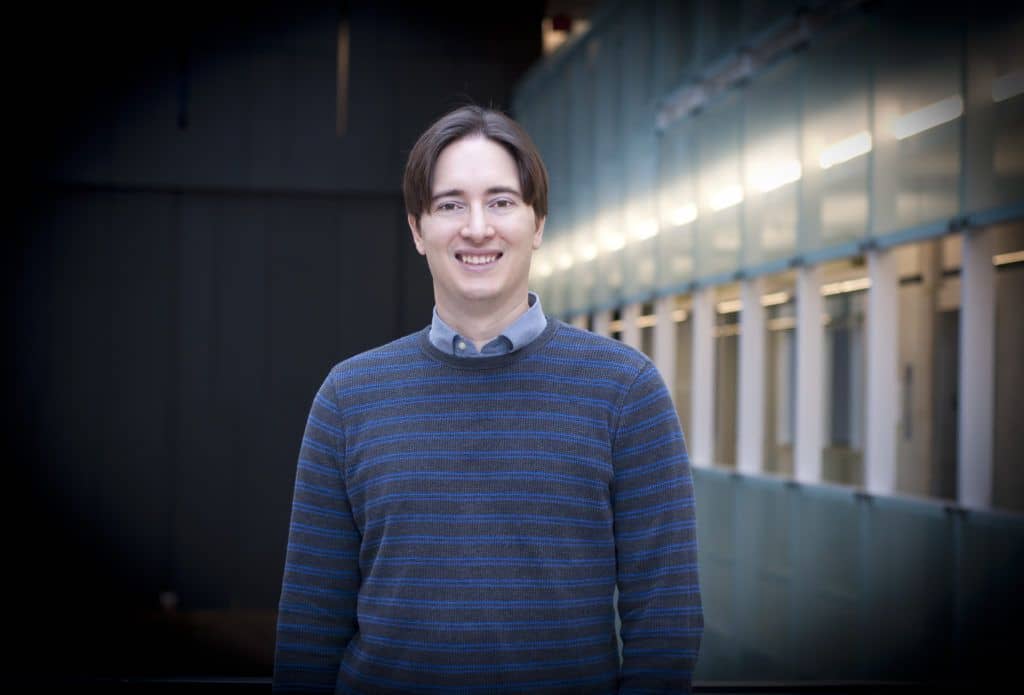Researchers flourish in the overlap between math and physics
Whether they are probing higher dimensions or trampling over boundaries, Kevin Costello and Davide Gaiotto are having a blast – and making breakthroughs.
Take a self-guided tour from quantum to cosmos!
Whether they are probing higher dimensions or trampling over boundaries, Kevin Costello and Davide Gaiotto are having a blast – and making breakthroughs.

Physicists say the universe is a book written in the language of mathematics. Mathematicians aren’t sure why physicists are only interested in the one book.
For centuries – at least as far back as Newton inventing calculus to make classical mechanics work – math and physics have worked alongside, against, and across each other. The boundaries between them have proven blurry and shifting. But that hasn’t stopped practitioners fiercely defending them.
And then there’s Kevin Costello and Davide Gaiotto.
One is a mathematician, the other a physicist. Together, they’re a powerful scientific force.
Costello is the mathematician – in 2013, already considered one of the best young mathematicians in the world, he became the first mathematician to join Perimeter’s faculty. “What’s unique about Kevin Costello,” said Ed Witten, at the time, “is that he’s a great mathematician who goes much more deeply into the physics than other outstanding mathematicians in similar areas do.” Costello won the Berwick Prize in 2017, and in 2018 was elected a Fellow of the Royal Society.
Gaiotto is the physicist – specifically, a mathematical physicist with an interest in the mathematical properties and applications of quantum field theories. With honours like the 2012 New Horizons Prize and the 2011 Gribov Medal, he’s likewise considered one of the leading minds in his field.
“To my mind, Davide and Kevin are what’s great about PI,” says Perimeter’s director Robert Myers. “At any university, either would be a standout professor. But together, at Perimeter, they are a real research powerhouse.”
As for the boundaries between mathematics and physics, the pair crosses them with glee – if they notice them at all. “I think the distinction between mathematics and mathematical physics is that I don’t prove theorems,” says Gaiotto, the physicist.
“Yes, you do,” says Costello, the mathematician.
“Not in a way that would satisfy a mathematician,” says Gaiotto.
Costello shoots him a look that reads, “What am I, chopped liver?” then adds: “The distinction is … it’s mostly a meaningless distinction, what gets labelled math and what gets labelled mathematical physics.”
He cites some of Gaiotto’s previous work – in exploring something called the geometric Langlands program – which ended up pushing mathematics forward as fast as, or faster than, it pushed physics. “Whether something is labelled mathematics or physics mostly just determines what kind of job you can apply for later. Our students do worry about it.”
Adds Gaiotto: “But we have tenure, so we don’t care.”
Not only do the pair have tenure, they hold two of Perimeter’s named chairs. They even share a funder. Gaiotto holds the Krembil Galileo Galilei Chair, and Costello holds the Krembil William Rowan Hamilton Chair. The Krembil Foundation recently renewed funding for both prestigious appointments, allowing Costello and Gaiotto to continue their powerhouse collaboration.

They have several different projects going – in fact, they rarely work apart.
“What we do is seek out problems that are both physically interesting and mathematically rigorous,” says Gaiotto. “I think I’m only doing one project that’s not Kevin related.”
“I am doing some work generalizing something that I did with Davide – our holography paper – but otherwise…” Costello confirms.
They offer a taste of one of their projects, studying integrability. Gaiotto attempts to describe the concept: “Suppose you’re looking at the motion of a planet around a sun. It goes around the sun once, then it comes back exactly in the same place with the same speed it had on its previous orbit.”
It’s not obvious that the orbit should repeat like that. In fact, it’s surprising – why does the planet not spirograph all over the place in a complicated way? Indeed, throw in a third orbiting body, interacting with the first, and that’s exactly what happens.
The two-body orbit is integrable. The three-body orbit is not.
“Typically, integrable systems are the only ones where you can find exact solutions to your problem. Most systems are not like this,” says Gaiotto. “But the ones that are tend to be interesting and special.” The orbit of a planet, the energy levels of a hydrogen atom, even the quantum field theory beloved of mathematical physicists, N=4 Super Yang-Mills, are all integrable systems.
These systems have something in common: the mathematics describing them has a lot of symmetry. That symmetry in the math corresponds to conserved quantities in the actual system.

If you have enough conserved quantities, the motion becomes very restricted. In the case of the motion of a planet around a sun, a neat orbit is not guaranteed by conservation of energy or momentum. Fortunately, the gravitational force has mathematical symmetries that introduce extra conserved quantities.
Ultimately, Gaiotto explains, it’s the symmetry in the mathematics that makes a system integrable. But spotting those symmetries – and thus uncovering new integrable systems – isn’t always easy. Symmetries can be hidden, sometimes deeply.
In both physics and mathematics, people have spent entire careers looking for new integrable systems. It’s a thriving field of study employing hundreds, maybe thousands, of researchers, but it can be as much art as science. “People who study integrability see pattern – they say, here is something that tends to happen and probably will happen again,” says Gaiotto. “It’s an artistry.”
“It takes intuition and genius,” says Costello.
Or it used to – before the pair made a breakthrough. “Kevin found a beautiful way to explain why integrability exists in all those systems,” says Gaiotto. “I am working with him to explore some of the consequences of his explanation.”
“So it turns out,” says Costello, “that a lot of these systems secretly come from something in higher dimensions. For those integrable systems, their integrable properties can be explained by observing their equations in some higher dimensional set-up.”
In other words, integrable systems in two dimensions are shadows of mathematical objects in four dimensions. The symmetries in the higher dimensions introduce conserved quantities that are present even in the shadow.
That lets the researchers predict which systems will be integrable. “In the higher dimensional situation, it’s kind of obvious that it’s integrable,” says Costello. “In lower dimensions, it’s not obvious – the symmetries are hidden – but the integrability is still there.”
But the higher dimensional set-up allows the researchers to do more than predict which systems are integrable and which ones are not. “You can actually construct new integrable systems, and find systematic ways to solve the old ones, by recognizing that there is this universal structure behind,” says Gaiotto.
It’s a stunning piece of reframing, and an example of the kind of thing that can happen when physicists and mathematicians work together – something that Costello and Gaiotto think is still too rare.
“Other places have tried to bring math and physics together, but I’m not sure if they’ve been successful,” says Costello.
Gaiotto nods. “I would say, not much.”
“It’s hard to get people who are willing to reach across to the other side,” Costello continues. “For younger people it’s a career risk, and older people can be set in their ways.”
At most universities, the division between departments or faculties can be enough to keep physicists and mathematicians away from one another. “But at Perimeter our students are all here, together,” says Gaiotto. “And not just the students. We are getting more mathematicians in the building, and we have a high concentration of physicists who are interested in math.”
Adds Costello: “We’ve even convinced some of the very pure mathematicians to talk about quantum field theory.” This summer, the pair helped organize a workshop called “QFT for mathematicians,” which – to their delight – attracted some high-level participants.
It’s just one of the things they do to draw mathematical physics and mathematics closer together. “We are making a concrete effort to make things happen,” says Gaiotto. “It’s not just accidental. It’s not that I think math needs to become more physical, or vice versa.”
This time it’s Costello who’s nodding along: “Each field has their own biases.”
Adds Gaiotto: “Each has strengths and weaknesses, but one thing I’m sure of is we do better together.”
In her May 12 webcast as part of the Perimeter Institute Public Lecture Series, Emily Riehl will explore the fascinating mathematics providing solutions to a matchmaker’s dilemma.
On Wednesday, May 5 at 7 pm ET, Perimeter Institute presents a special public talk by Harvard University’s L. Mahadevan, who will explain how the intersections of physics, biology, and mathematics are unveiling the amazing complexity of life.
The discovery of a set of peculiar quantum field theories opened up a bounty of unsolved problems. Two Perimeter researchers set out to explore this uncharted territory.